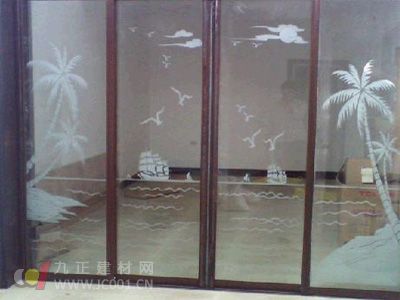Frosting refers to the adhesion of glass glaze powder of a certain size to the glass of the product. After baking at 580~600 °C, the glass glaze coating is melted on the surface of the glass and shows a color different from that of the glass body. a decorative method.
Adhesive glass glaze powder, can be brushed with a pen, or can be rolled with a rubber roller. Through the silk screen processing, the floor pattern of the frosted surface can be obtained. The method comprises: silk-screening a pattern pattern formed by a flux-blocking agent on the surface of the glass article. After the pattern pattern to be printed is air-dried, it is subjected to frosting. Then, after high-temperature baking, the frosted surface without the pattern pattern is melted on the glass surface, and the place where the silk screen pattern is applied is not melted on the glass surface due to the action of the flux inhibitor. After baking, the transparent floor pattern appears through the translucent sand surface, forming a special decorative effect. Frosted silk screen printing resistant consists of ferric oxide, talc, clay, etc., ground with a ball mill, with a fineness of 350 mesh, and blended with a binder before silk screen printing.

Making frosted glass process: draft - screen version - printing glass etching ink - washing - finished product
1. Draft: Design the desired pattern with a computer. The small format can be outputted by a laser printer, and the large format can be engraved on a black sticky note by a computer engraving machine or output by a laser phototyper.
2. Web version: Please use 100-180 mesh polyester mesh for the screen. It is best to use monofilament polyester mesh as the best.
3. Printing glass etching ink, before printing, it is necessary to remove the stain and wet of the glass surface, fully mix the frosting paste (ie screen printing ink), avoid using iron, and preferably use "bamboo wood" products. When printing, it is necessary to smear twice on the screen, the purpose of which is to increase the ink. For example, by hand printing, the etching ink can be scraped from one end to the other end, and then the blade is lifted to the back of the ink, and then scraped to the end of the printing. Its purpose is to increase the printing material. This means that the desired amount of ink is achieved on the glass surface. If the printing is done in winter, the etching ink should be heated to 20 ° C - 40 ° C for best use. Float glass must be used when using glass, and flat glass is not desirable. Because the thickness of the glass is uneven, after the hot pressing of the glass, the unevenness of the cooling makes the material structure of the glass uneven, so even after printing, the planar effect of the etching is uneven.
4. Rinse, park the first printed glass for three minutes, then rinse it in the pool or rinse it with tap water. After the water on the glass is dry, it will show a snow-like pattern. This kind of glass is very popular in the market and is loved by consumers.
Using the above process, tea sets, handicrafts, gift glasses, glass containers, etc. can be produced.
T-Bolt, known as hammer bolt in European standard, is made of galvanized or nickel plated carbon steel surface. T-shaped bolt can be directly put into the aluminum profile groove. During installation, it can be automatically positioned and locked. It is often used in conjunction with flange nuts. It is a standard matching connector when installing corner pieces. It can be selected according to the profile groove width and different series of profiles. T-bolts are movable foundation bolts.
T-Bolt,T Bolt,T Bolts,T Head Bolt
Jiangsu Jiajie Special Screw Co., Ltd , https://www.jiajiescrewcompany.com
